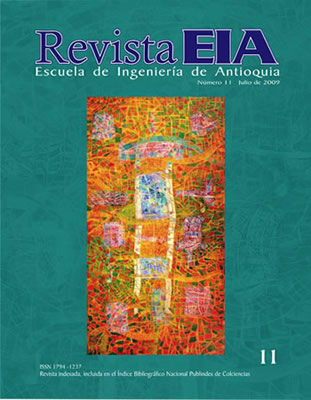EFECTO DE LA TEMPERATURA SOBRE LA RESISTENCIA A LA TRACCIÓN DE ALGUNOS REFUERZOS DE FIBRAS PARA MATRICES CERÁMICAS O POLIMÉRICAS (EFFECT OF TEMPERATURE ON TH E TENSILE STRENGTH OF SOME FIBER REINFORCEMENTS FOR CERAMIC OR POLYMER MATRICES)
EFECTO DE LA TEMPERATURA SOBRE LA RESISTENCIA A LA TRACCIÓN DE ALGUNOS REFUERZOS DE FIBRAS PARA MATRICES CERÁMICAS O POLIMÉRICAS (EFFECT OF TEMPERATURE ON TH E TENSILE STRENGTH OF SOME FIBER REINFORCEMENTS FOR CERAMIC OR POLYMER MATRICES)


This work is licensed under a Creative Commons Attribution-NonCommercial-NoDerivatives 4.0 International License.
Copyright statement
The authors exclusively assign to the Universidad EIA, with the power to assign to third parties, all the exploitation rights that derive from the works that are accepted for publication in the Revista EIA, as well as in any product derived from it and, in in particular, those of reproduction, distribution, public communication (including interactive making available) and transformation (including adaptation, modification and, where appropriate, translation), for all types of exploitation (by way of example and not limitation : in paper, electronic, online, computer or audiovisual format, as well as in any other format, even for promotional or advertising purposes and / or for the production of derivative products), for a worldwide territorial scope and for the entire duration of the rights provided for in the current published text of the Intellectual Property Law. This assignment will be made by the authors without the right to any type of remuneration or compensation.
Consequently, the author may not publish or disseminate the works that are selected for publication in the Revista EIA, neither totally nor partially, nor authorize their publication to third parties, without the prior express authorization, requested and granted in writing, from the Univeridad EIA.
Show authors biography
Este artículo presenta un estudio de las propiedades termomecánicas de fibras de acero de bajo carbono, de acero inoxidable ASI-SAE 304, de aramida y de carbono. Además, se analizó el aspecto superficial de refuerzos de lana mineral de roca y lana de aluminosilicatos antes y después de someterlos a tratamientos térmicos a 1000 ºC. La resistencia a la tracción de las fibras se evaluó antes y después de someterlas a tratamientos térmicos a temperaturas de 400, 600, 800 y 1000 ºC dependiendo de la degradación que mostraran. Además, se efectuó un análisis termogravimétrico a cada tipo de fibra para determinar los cambios de peso a diferentes temperaturas. Las fibras de acero inoxidable mostraron la mayor estabilidad termomecánica, mientras que las fibras de aramida con tratamientos a 400 ºC mostraron propiedades mecánicas prácticamente nulas.
Abstract: This paper presents a study of the thermomechanical properties of low carbon steel, AISI-SAE 304 stainless steel, aramid and carbon fibers. Moreover, surface aspect of mineral rock wool of and aluminosilicate wool reinforcements was analyzed prior and after submitting to heat treatments at 1000 ºC. The tensile resistance of the fibers was evaluated prior and after submitting to heat treatments at temperatures of 400, 600, 800 and 1000 ºC depending on the degradation that they showed. Moreover, a thermogravimetric analysis was carried out on each kind of fiber to determine the changes in weight at different temperatures. The stainless steel fibers showed the highest mechanical stability, whereas the aramid fibers with treatments at 400 ºC showed practically null mechanical properties.
Article visits 324 | PDF visits 132
